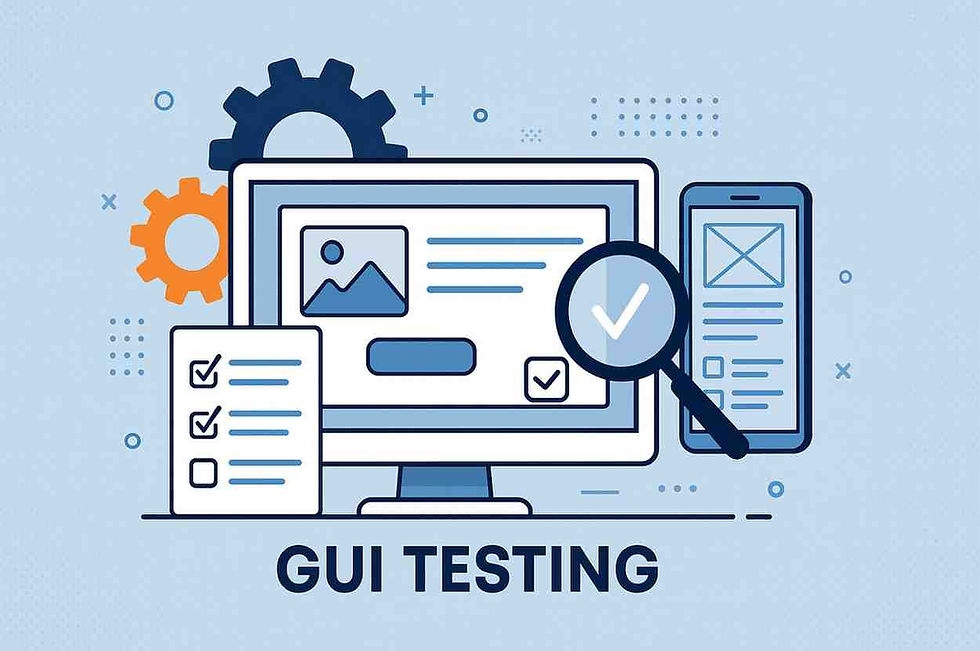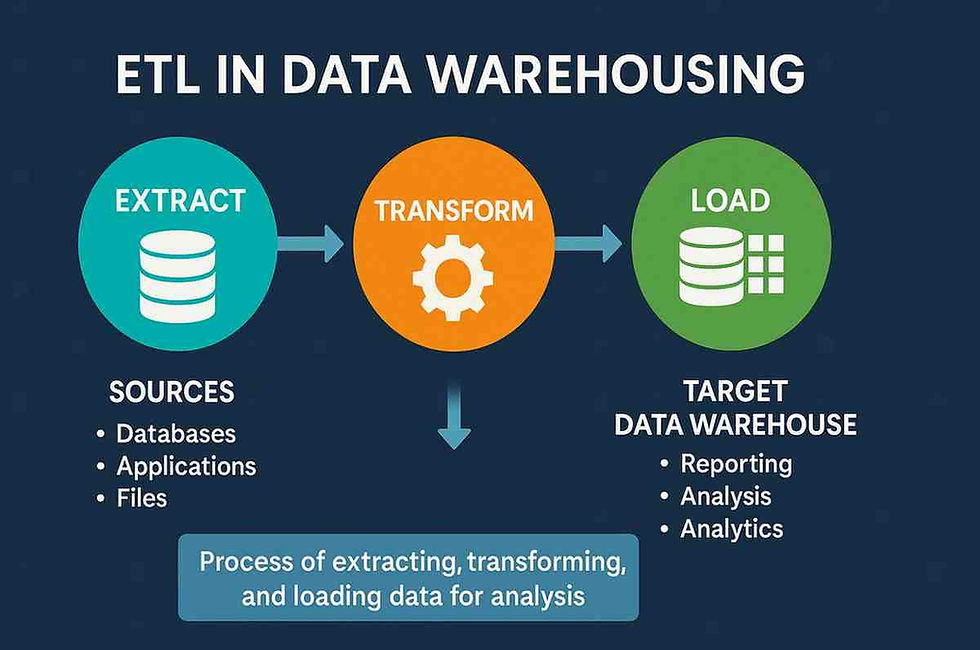GUI in Testing: Guide for Software Testers & QA Engineers 2025
- Gunashree RS
- May 27
- 8 min read
User interfaces are the gateway between users and software applications, making GUI testing one of the most critical aspects of software quality assurance. Whether you're testing a web application, mobile app, or desktop software, understanding how to effectively test graphical user interfaces can make the difference between a successful product launch and frustrated users abandoning your application.
GUI testing goes far beyond simply clicking buttons and filling out forms. It involves validating visual elements, ensuring accessibility compliance, verifying responsive design, and confirming that the user experience meets both functional and aesthetic requirements. In today's competitive digital landscape, users expect flawless interfaces that work seamlessly across different devices, browsers, and operating systems.
This comprehensive guide will cover everything you need to know about GUI testing, from fundamental concepts to advanced automation strategies. Whether you're a seasoned QA professional or just starting your journey in software testing, you'll discover practical techniques and industry best practices to elevate your GUI testing capabilities.

Understanding the Fundamentals of GUI Testing
GUI testing, also known as user interface testing, focuses on validating the graphical elements of an application to ensure they function correctly and provide an optimal user experience. Unlike backend testing, that focuses on data processing and business logic, GUI testing examines how users interact with visual components like buttons, menus, forms, images, and navigation elements.
The primary objective of GUI testing is to verify that the application's interface behaves as expected under various conditions and user interactions. This includes testing visual consistency, functionality of interactive elements, proper display across different screen sizes, and overall usability. GUI testing helps identify issues that could impact user satisfaction, such as broken links, misaligned elements, slow loading times, or confusing navigation patterns.
Modern GUI testing encompasses multiple dimensions, including functional testing of interface elements, visual regression testing to catch unintended changes, accessibility testing for users with disabilities, and cross-browser compatibility testing. Each dimension requires specific approaches and tools to ensure comprehensive coverage of potential issues that could affect end users.
Essential Components and Elements in GUI Testing
When conducting GUI testing, testers must evaluate numerous interface components that collectively create the user experience. Understanding these elements and their testing requirements is crucial for developing effective test strategies.
Visual Elements and Layout Testing: This involves verifying that all visual components display correctly, including text formatting, color schemes, image rendering, and overall layout consistency. Testers check for proper alignment, spacing, font consistency, and visual hierarchy. Issues like overlapping elements, cut-off text, or inconsistent styling can significantly impact user perception and usability.
Interactive Components Validation: Buttons, links, dropdown menus, checkboxes, radio buttons, and form fields require thorough testing to ensure they respond appropriately to user interactions. This includes verifying click events, hover effects, focus states, and proper feedback mechanisms. Each interactive element should provide clear visual cues about its state and function.
Navigation and User Flow Testing: Testing navigation menus, breadcrumbs, pagination, and overall user journey through the application ensures users can efficiently accomplish their goals. This includes validating that navigation is intuitive, consistent across pages, and provides appropriate feedback about the user's current location within the application.
Form and Input Validation: Forms are critical touchpoints where users provide information, making their testing essential. This involves validating input fields, error messages, validation rules, submission processes, and data handling. Proper form testing ensures data integrity while providing a smooth user experience.
Manual GUI Testing Techniques and Best Practices
Manual GUI testing remains an essential component of comprehensive testing strategies, offering unique advantages in identifying usability issues and user experience problems that automated tests might miss.
Exploratory Testing Approach: This involves systematically exploring the application's interface while simultaneously learning about its functionality and identifying potential issues. Testers navigate through different sections, try various user scenarios, and observe how the interface responds to different interactions. This approach is particularly effective for discovering unexpected behaviors and usability problems.
Cross-Browser and Cross-Platform Testing: Manual testing across different browsers, operating systems, and devices helps identify compatibility issues that could affect significant portions of your user base. Testers verify that the interface functions consistently across Chrome, Firefox, Safari, Edge, and mobile browsers, noting any discrepancies in appearance or functionality.
Usability and User Experience Evaluation: Manual testing allows testers to evaluate the application from a user's perspective, identifying confusing workflows, unclear instructions, or frustrating interaction patterns. This human insight is invaluable for improving overall user satisfaction and reducing support requests.
Accessibility Testing: Manual accessibility testing involves using screen readers, keyboard navigation, and other assistive technologies to ensure the application is usable by people with disabilities. This includes verifying proper heading structures, alt text for images, keyboard accessibility, and color contrast compliance.
Automated GUI Testing Tools and Frameworks
Automation has revolutionized GUI testing by enabling faster execution, broader coverage, and more consistent results. Modern automated testing tools provide sophisticated capabilities for validating user interfaces across different platforms and configurations.
Selenium WebDriver and Ecosystem: Selenium remains the most popular framework for web application GUI testing, supporting multiple programming languages and browsers. It enables testers to automate user interactions, validate page elements, and create comprehensive test suites. Advanced Selenium implementations include page object models, data-driven testing, and parallel execution capabilities.
Modern Testing Frameworks: Tools like Cypress, Playwright, and TestCafe offer improved developer experience with features like real-time browser preview, automatic waiting, and built-in debugging capabilities. These frameworks often provide better reliability and maintenance compared to traditional Selenium-based solutions.
Visual Testing and Regression Detection: Specialized tools like Applitools, Percy, and Chromatic focus on visual regression testing by capturing screenshots and comparing them against baseline images. These tools can automatically detect visual changes, pixel differences, and layout shifts that might indicate bugs or unintended modifications.
Mobile GUI Testing Tools: Appium, Espresso, and XCUITest enable automated testing of mobile applications across iOS and Android platforms. These tools can simulate touch gestures, device rotations, and various mobile-specific interactions while validating the mobile user interface.
Advanced GUI Testing Strategies and Methodologies
Sophisticated GUI testing requires strategic approaches that balance thoroughness with efficiency while adapting to modern development practices and user expectations.
Test Pyramid Implementation: Effective GUI testing follows the test pyramid principle, with a large base of unit tests, a moderate number of integration tests, and a focused set of end-to-end GUI tests. This approach ensures comprehensive coverage while maintaining fast feedback cycles and manageable maintenance overhead.
Risk-Based Testing Prioritization: Advanced teams prioritize GUI testing efforts based on user impact, business criticality, and historical defect patterns. High-traffic user flows, revenue-generating features, and previously problematic areas receive more intensive testing attention.
Continuous Integration and Deployment: Modern GUI testing integrates seamlessly with CI/CD pipelines, providing automated feedback on interface changes before they reach production. This includes automated screenshot comparisons, accessibility checks, and cross-browser validation as part of the development workflow.
Performance and Load Considerations: GUI testing increasingly includes performance aspects, validating that interfaces remain responsive under various load conditions. This involves testing page load times, interactive element responsiveness, and visual stability during high-traffic scenarios.
Emerging Trends and Future of GUI Testing
The landscape of GUI testing continues to evolve rapidly, driven by new technologies, changing user expectations, and advances in testing methodologies.
AI and Machine Learning Integration: Artificial intelligence is transforming GUI testing through smart element identification, self-healing test scripts, and intelligent test case generation. AI-powered tools can adapt to interface changes, reduce maintenance overhead, and identify patterns that human testers might miss.
Visual AI and Computer Vision: Advanced visual testing tools now use computer vision algorithms to understand interface layouts, identify elements semantically rather than through rigid selectors, and detect visual anomalies with human-like perception.
Cloud-Based Testing Platforms: Cloud testing services provide access to diverse browser and device combinations without maintaining extensive local infrastructure. These platforms offer scalability, real device testing, and global testing capabilities that were previously cost-prohibitive for many organizations.
Accessibility and Inclusive Design Focus: Growing legal requirements and social awareness are driving more comprehensive accessibility testing. Modern GUI testing increasingly incorporates automated accessibility checks, inclusive design validation, and testing with actual assistive technologies.
Frequently Asked Questions
Q: What is the difference between GUI testing and functional testing?
A: GUI testing specifically focuses on the user interface elements and their visual/interactive behavior, while functional testing validates business logic and application functionality regardless of the interface. GUI testing is a subset of functional testing that emphasizes user experience aspects.
Q: How do you handle dynamic elements in GUI testing?
A: Dynamic elements can be handled using explicit waits, dynamic locators, and flexible element identification strategies. Modern testing frameworks provide built-in mechanisms to wait for elements to appear, change state, or become interactable before proceeding with test actions.
Q: What are the main challenges in GUI test automation?
A: Common challenges include maintaining test scripts when interfaces change, handling different browser behaviors, managing test data, dealing with timing issues, and ensuring tests remain stable across different environments and configurations.
Q: How do you test responsive design effectively?
A: Responsive design testing involves validating layouts across multiple screen sizes, testing breakpoints, verifying touch interactions on mobile devices, and ensuring content remains accessible and functional on different viewport dimensions.
Q: What metrics should be tracked for GUI testing effectiveness?
A: Key metrics include test coverage percentage, defect detection rate, test execution time, maintenance effort, user satisfaction scores, and the number of production issues related to GUI problems.
Q: How do you prioritize GUI test cases?
A: Prioritization should be based on user impact, business criticality, risk assessment, frequency of use, and historical defect data. High-priority test cases typically cover critical user journeys, revenue-impacting features, and previously problematic areas.
Q: What role does accessibility play in GUI testing?
A: Accessibility testing ensures applications are usable by people with disabilities, meeting legal requirements and expanding the user base. It involves testing with screen readers, keyboard navigation, color contrast validation, and compliance with standards like WCAG.
Q: How do you integrate GUI testing into agile development processes?
A: Integration involves creating automated test suites that run in CI/CD pipelines, maintaining test cases alongside feature development, conducting sprint-based testing activities, and ensuring rapid feedback on interface changes.
Conclusion
GUI testing represents a critical intersection between technical validation and user experience optimization. As applications become increasingly complex and user expectations continue to rise, effective GUI testing strategies become essential for delivering successful software products.
The evolution from purely manual testing approaches to sophisticated automated frameworks reflects the industry's recognition that comprehensive GUI testing requires both human insight and technological efficiency. Modern teams that successfully balance manual exploration with automated regression testing, visual validation with functional verification, and accessibility compliance with performance optimization will deliver superior user experiences.
Success in GUI testing demands continuous learning and adaptation to new tools, techniques, and user interface paradigms. The investment in robust GUI testing practices pays dividends through reduced production defects, improved user satisfaction, and more confident software releases.
Remember that effective GUI testing is not just about finding bugs—it's about ensuring that your application provides the seamless, intuitive, and accessible experience that users expect in today's digital landscape. By implementing the strategies and best practices outlined in this guide, you'll be well-equipped to deliver high-quality user interfaces that delight users and drive business success.
Key Takeaways
• GUI testing validates both functional behavior and visual presentation of user interface elements
• Manual testing remains essential for usability evaluation and exploratory testing scenarios
• Automated GUI testing tools like Selenium, Cypress, and Playwright enable comprehensive coverage and faster feedback
• Visual regression testing helps maintain a consistent appearance across application updates and changes
• Cross-browser and cross-platform testing ensures compatibility across diverse user environments
• Accessibility testing is crucial for legal compliance and inclusive user experience design
• Integration with CI/CD pipelines enables continuous validation of interface changes
• Risk-based prioritization focuses testing efforts on high-impact areas and critical user journeys
• AI and machine learning are transforming GUI testing through intelligent automation and maintenance
• Cloud-based testing platforms provide scalable access to diverse testing environments and real devices
Sources
International Software Testing Qualifications Board (ISTQB) - GUI Testing Guidelines
World Wide Web Consortium (W3C) - Web Accessibility Guidelines and Testing Standards
Selenium Official Documentation - WebDriver Best Practices and Implementation Guide
Google Web Fundamentals - Cross-Browser Testing and Compatibility Guidelines
Mozilla Developer Network - User Interface Testing and Accessibility Resources
Software Testing Help - Comprehensive GUI Testing Methodologies and Techniques




GUI testing is often underestimated, even though visual details shape the first impression of a product. We once had a case in our team where a client rejected a release due to a minor graphical bug, and we realized that the interface requires just as much attention as the code logic. After that project, I became more mindful of the systematic nature of processes, even in documentation. When searching for an invoice automation solution, I came across invoice to go , where users were discussing how to organize financial tasks. And surprisingly, the approach to time management turned out to be very similar to interface testing: everything is based on precision and transparency.
Link INDOVIP138
indovip138
indovip138
indovip138
indovip138
indovip138
indovip138
indovip138
indovip138
indovip138
indovip138
indovip138
indovip138
indovip138
indovip138
indovip138
indovip138
indovip138
indovip138
indovip138
indovip138
indovip138
indovip138
indovip138
indovip138
indovip138
indovip138
indovip138
indovip138
indovip138
indovip138
indovip138
indovip138